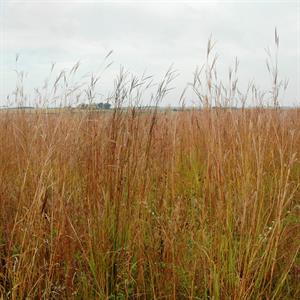Duane Hovorka, IWLA Agriculture Program Director
 In December, Congress approved a new five-year Farm Bill that will provide full funding for conservation programs that help farmers put in place conservation systems that address soil, water, and wildlife needs in rural areas. Farm Bill conservation programs provide $6 billion per year – the largest single source of funding for private lands conservation in America.
In December, Congress approved a new five-year Farm Bill that will provide full funding for conservation programs that help farmers put in place conservation systems that address soil, water, and wildlife needs in rural areas. Farm Bill conservation programs provide $6 billion per year – the largest single source of funding for private lands conservation in America.
The U.S. has lost millions of acres of native prairie over the past decade, making native prairie one of the most endangered ecosystems in North America. While there is some good news for prairie and other grasslands in the new Farm Bill, the new law also represents lost opportunities to better protect these valuable resources.
SodSaver
The League worked hard to protect SodSaver, a provision of the 2014 Farm Bill that reduces federal crop insurance premium subsidies for farmers who plow under or break out native prairie to plant crops. The SodSaver provision helps ensure that taxpayer-supported crop insurance will not subsidize the destruction of native prairie, but it currently only applies to six states on the Northern Great Plains: Montana, North Dakota, South Dakota, Nebraska, Minnesota, and Iowa.
The League worked hard to expand SodSaver to protect native prairie nationwide. We produced fact sheets on how SodSaver would help protect prairie in 8 key states, from coastal prairies in California and shortgrass prairie in Colorado to the dry prairie of central Florida. We advocated for the American Prairie Conservation Act to expand SodSaver, which was introduced in the Senate by Senators John Thune (R-SD), Amy Klobuchar (D-MN), Mike Rounds (R-SD), and Michael Bennett (D-CO). In the House, Representatives Kristi Noem (R-SD) and Tim Walz (D-MN) introduced the bill. Both bills were co-sponsored by other members of Congress.
But despite broad support from hundreds of conservation groups, the new Farm Bill does not expand SodSaver coverage to other states.
Conservation Easements
The Agricultural Conservation Easement Program will see an increase in funding to $450 million per year – 11% more than the 2014 Farm Bill. The funds are used to conserve and permanently protect native prairie, wetlands, and other farmland. The new law also streamlines the program, which will make it easier for conservation groups to use it to obtain prairie and wetland easements.
National Grasslands
More than 3.8 million acres in 20 national grasslands are managed by the USDA Forest Service, much of it restored or native prairie. The good news is that provisions from the House bill that would have reduced public input into Forest Service decisions were not included in the final Farm Bill. That will ensure that conservation voices will be heard in decisions that impact these grasslands, which provide habitat for grassland wildlife and are open for public use.
Other Grasslands
The new law expands the Conservation Reserve Program (CRP) to 27 million acres (from 24 million acres). This program pays farmers to convert highly erodible and marginal cropland to grassland, shrub land, or woodland through 10-15 year contracts.
However, the law will substantially reduce the rent and other incentives offered to farmers to enroll in the program. As USDA learned in a CRP signup last summer, even with low crop prices, few farmers are willing to take cropland out of production without adequate incentives.
With the new law, USDA can now pay part of the cost of installing fencing and water systems under CRP contracts, which could convince more farmers to keep the land in grass for grazing livestock rather than converting it back to cropland when the contracts expire. The new law instructs USDA to enroll 2 million acres through the CRP grasslands initiative, which provides contracts for conserving existing grasslands that will be hayed or grazed, including expiring CRP contracts. To date, USDA has enrolled about 1 million acres in the initiative.
Other USDA programs could also contribute to grassland conservation. The new law will increase funding for the Regional Conservation Partnership Program, which creates federal-state-local partnerships to solve high-priority natural resource problems. The program has been used to conserve prairie that is important for wildlife such as the lesser prairie chicken in Kansas and Oklahoma and greater sage grouse in California and Nevada. Rewards for better grazing management will be increased under the Conservation Stewardship Program, helping ranchers better manage native prairie and other grasslands.
Altogether, the funding and policy changes in the new Farm Bill should help maintain many existing grasslands, and the increase in CRP acres should help restore grass on several million acres of marginal cropland. But the new law will do little to slow the ongoing conversion of native prairie to cropland, nor will it reverse the destruction of millions of acres of native prairie converted to cropland over the past decade.
Although the League didn’t get everything we asked for in the new Farm Bill, Congress did renew America’s commitment to funding vital farm and ranch conservation programs for another five years.
Watch for more updates on the new Farm Bill.